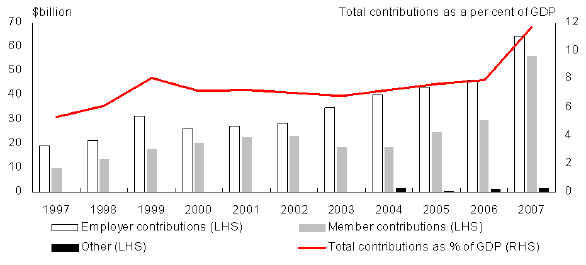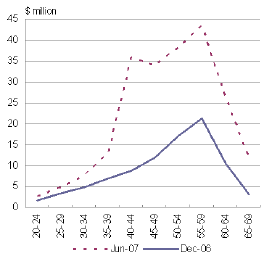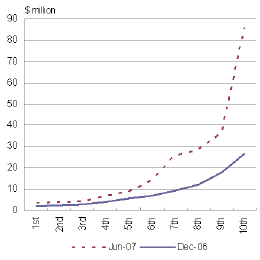The Better Super package generally came into effect on 1 July 2007. From May 2006 to June 2007, people could take advantage of special transitional arrangements, most notably the ability to contribute up to $1 million of non-concessional contributions before the new contribution limits came into effect. While it is still too early to be confident about any long-term changes in super behaviour due to Better Super, some data is now available about the take-up of the transitional arrangements.
Voluntary contributions to super rose dramatically in the June 2007 quarter, as people took advantage of the transitional arrangements around the introduction of Better Super (see Chart 27, 28 and 29).
Chart 27: Aggregate employer, member and other contributions

Source: Celebrating 10 years of superannuation data collection 1996 2006, APRA’s Insight publication, Issue 2 2007, Special Edition (issued 26 July 2007); Annual Superannuation Bulletin, Australian Prudential Regulation Authority, June 2007 (issued 26 March 2008) and the Australian Bureau of Statistics (ABS Cat. No. 5206.0).
From the second AMP Adequacy Index Report22 it is clear that older and higher income people were responsible for the bulk of the increase in contributions (see Chart 4 & 5).
Chart 28: Total voluntary contributions to super by age

Chart 29: Total voluntary contributions to super by salary decile

Source: AMP Superannuation Adequacy Index Report, January – June 2007 (Chart 3, page 10).
The Better Super arrangements also improve the relative benefit of contributions to superannuation compared with alternative ways of saving for retirement, subject to not exceeding contribution caps on both concessional and non-concessional contributions. As noted above, Treasury has limited access to up to date information on the impact of Better Super on voluntary contribution rates. The one off surge in 2006-07 shown in Chart 27, 28 and 29 has been incorporated into RIMGROUP. AMP Financial Services has released three Reports projecting the adequacy of Australian retirement incomes. The projections are based on up to date information of more than 320,000 AMP members and allows some analysis of the impact of Better Super. The AMP Report for July – December 200723 notes the surge in super contributions seen in 2006-07 associated with Better Super has abated as expected, but voluntary contributions, particularly at older ages, remain generally higher in percentage terms than before Better Super. Table 1 below, reproduced from the May 2008 AMP Report illustrates this, including both compulsory and voluntary, concessional and non-concessional contributions. The published AMP data is not in sufficient detail by gender and income to fully update RIMGROUP for Better Super, and is not necessarily fully representative of the whole population, but it has been used to inform the assumptions made.
| Dec-06 | Jun-07 | Dec-07 | |
|---|---|---|---|
| 20‑24 | 10.1% | 11.0% | 10.1% |
| 25‑29 | 10.2% | 11.0% | 10.2% |
| 30‑34 | 10.7% | 11.4% | 10.6% |
| 35‑39 | 10.8% | 12.4% | 10.9% |
| 40‑44 | 11.3% | 16.7% | 11.6% |
| 45‑49 | 13.7% | 17.7% | 12.8% |
| 50‑54 | 14.4% | 21.5% | 16.0% |
| 55‑59 | 18.1% | 28.4% | 19.4% |
| 60‑64 | 21.6% | 40.0% | 25.0% |
| 65‑69 | 25.5% | 56.5% | 24.4% |
| All | 12.6% | 17.2% | 13.0% |
Source: AMP Superannuation Adequacy Index Report, July – December 2007 (Table 2, page 9).
22 AMP Superannuation Adequacy Index Report, January – June 2007.
23 AMP Superannuation Adequacy Index Report, July – December 2007.